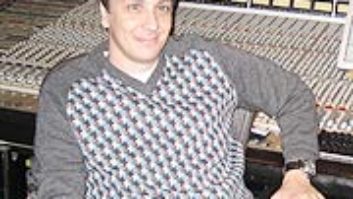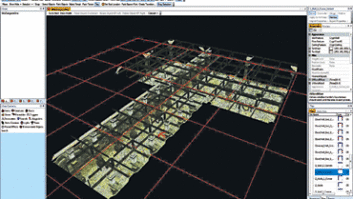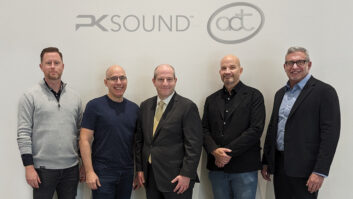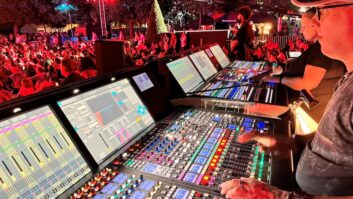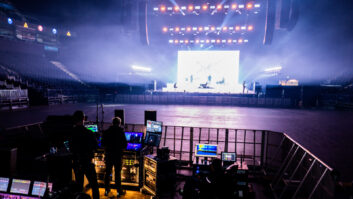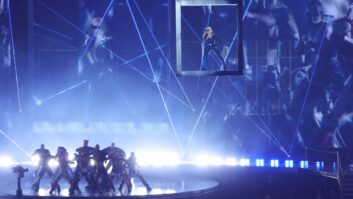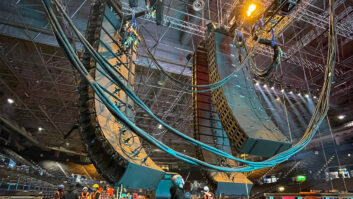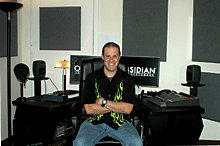
I have built three audio studio/departments during my decade-long stint in interactive/game sound. The latest is a temporary setup for Los Angeles-based Obsidian Entertainment, of which I am the new audio director. Obsidian is not a multimillion recording/mixing facility on the scale of the new Sony game complex in San Diego or Electronic Arts’ studios in Vancouver. We’re a smaller, workhorse company focusing on integrating audio from outside providers. But in the world of games, companies like Obsidian do a lot of the work, and $25,000 is enough to equip a productive room if we choose our resources wisely.
Obsidian Entertainment audio director (and Mix columnist) Alex Brandon designed this temporary studio for game audio integration.
Obsidian is run by Feargus Urquhart, who, along with the other four company owners (Chris Jones, Darren Monahan, Chris Avellone and Chris Parker), has been developing top role-playing games such as Fallout and Knights of the Old Republic II. (Fallout was one of the first games to use Hollywood voice-over talent — Ron Perlman, David Warner and Tony Shalhoub.) Now, Obsidian is branching into more settings with developing a role-playing game based on the Alien film franchise and an upcoming expansion pack in the Dungeons and Dragons Forgotten Realms universe: Neverwinter Nights 2: Mask of the Betrayer.
Life as a developer, as compared to a publisher, has come a long way. When I started in this business more than 10 years ago, you were lucky if you could afford a top-of-the-line sound card (which at the time would have not been an Audiomedia III but a Sound Blaster AWE64). Publishers began building über-studios when record industry and film industry talent started talking with top game publishers; I can remember back to 1995 when Spencer Nielsen built Sega’s high-dollar in-house studio in San Francisco. At that time, developers had it rough. Budgets for games — in total — rarely hit $1 million and audio budgets would be, at most, $50k. Oddly enough, this is roughly the same as the 2 to 3 percent (up to 5 percent) that audio budgets in film allow (my sources being The Village’s budget on The Smoking Gun and Oscar-winning sound designer Randy Thom’s estimate on FilmSound.org).
These days, your average A-list game budget for any kind of action/adventure epic is around $15 to $20 million, with the top titles costing more than $30. You’d think that studios should at least be fairly generous to a developer with their audio budgets exceeding half-a-million. And sometimes they are, but not too often. At Obsidian, the top folks know the value that audio brings to a project, but as a developer they have to play the budget game with care. Not being a publisher with a profit margin the size of a small country’s gross national product, developers are in the industry’s most challenging position: to develop with just the right amount of risk and to yield fun and innovative gameplay without sinking your company if the market is fickle. Add to that risk the oversight of the publisher and licensors, and Obsidian has a huge set of challenges before it.
We’re at a point now where I’m directing the build-out of a true audio department. We’re starting small, even temporary, until we’re able to move into bigger digs. Still, there’s an awful lot to do. Right away, we have to integrate all of the audio in the aforementioned expansion pack, while coordinating integration, asset production and tech for two other larger-scale products, one of them being Aliens. What about “starting small”? Small means putting up about $25k to create a basic mix suite, complete with a top-of-the-line PC and two large LCD screens, decent control gear, a functional and pretty desk by Argosy, and acoustic diffusion and absorption by RPG. Oh, and a good set of sound libraries as a foundation for a custom one later on. I have the rudimentary tools to create killer music tracks, sounds and voice-over.
As far as workflow, the studio’s purpose is to provide direction to outsourced content providers and do as much integration on-site as possible. This means we must have maximum flexibility with just the right amount of control. So the studio doesn’t have to be top of the line for production, but it should provide an excellent monitoring environment and rudimentary asset-creation tools to fill in gaps, as well as prototype assets where needed.
Voice-over: I have an Audio-Technica 4040 mic on a tabletop boom with a good pop filter. This really is all you need for quick and dirty VO, especially for prototypes and audio concepting in pre-production. The limiting factors? The room I am in has no isolation and is adjacent to a hallway with an elevator. Loud footsteps, voices, anything with heavy bass or mids cuts through my facing wall like paper and into the mix. I also have a very low-key preamp with an ART TubeAMP. It works, but it doesn’t hold a candle to the hand-built Requisite at my last studio. A good Focusrite or TC Electronic preamp will be acquired for higher-quality VO. (Why provide prototype temp VO if it isn’t at least fairly close to the final product?) I also have Mike Troke from Micworks popping by to provide quotes on room floating.
Music: The setup for capturing or creating music is pretty straightforward. I can record live players as the room is pretty dead. I also have plenty of Giga libraries and Nuendo 3 to throw it all together in a surround mix if I need to. I listen to 5.1 surround (the norm in games these days) through Genelec’s Espresso system, which in my space (11×16 feet) is perfect. All that’s left is calibration and perhaps some love from Vortex. (Vortex was covered in the July issue’s column.)
Sound Effects: I’ve got 1.2 terabytes of sound effects ready for a database that I’ll be building this fall using Netmix. What a lot of companies don’t realize is that their sound effects, if they buy them outright, are available for future projects; we already have gigs available. As more audio staff come onboard, whether permanently or on a contract basis, we’ll be upgrading to Netmix Pro so the search engine can be operated as an internal server with intraweb-like access.
Foley: No need for it. Assets are mostly created out of house, so high-end Foley production isn’t a priority here. At studios like Technicolor and Soundelux, who’ve been doing it for years, Foley studios are great to have, especially if you have five-plus projects going at a time and have the same design criteria (for example, if you want an awful lot of differentiated dungeon doors and want to build them yourself beyond what you can find in libraries). In most cases, though, you’re better off letting the pros tackle Foley and instead focus on what really counts: how those doors sound in-game.
Speaking of in-game, that brings up another point: Mac vs. PC. What’s easier? Having a top-of-the-line PC that can run your game engine toolsets and your audio production toolsets, or creating audio on a Mac, networking them to a PC and then integrating them? Much easier to do the former. Only problem is, the recording industry is still very Mac-centric. There are two VO batch programs I’d love to get my hands on — voXover and VoicePro — but they’re Mac only. An awful lot of game developers’ lives would be easier if their tools were all on the same PC.
Another great thing about Windows XP is that it allows me to route output directly into my RME Multiface II and out to Espresso so that I can monitor gameplay at runtime (when you actually play the game, as opposed to working on it in an editor), as well as in the company’s editors, one of which is the highly extensible Neverwinter Nights 2 Toolset. This means using high-quality monitors to hear levels of your game as you’re playing it. Because the toolset is for use by anyone who buys a copy of the game, I’ll cover some of its features in a future column so you can actually see what goes into game audio implementation on the engine side.
This is a great start for an audio department — albeit a temporary one — and it didn’t cost much to get it going. The most important aspect of such an endeavor is having smart and professional teams to work with that understand audio’s importance in modern games, and Obsidian has that in spades.
Alexander Brandon is the audio director at Obsidian Entertainment.
